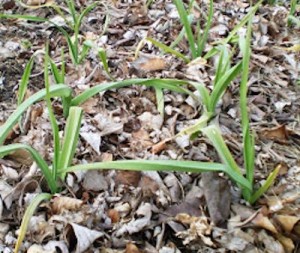Site Preparation
Garlic will tolerate some shade but prefers full sun. It grows best in loose, well-drained, rich, loamy soil amended with lots of organic matter (1 to 2 inches of compost). Raised beds are ideal. Compacted soil produces irregularly shaped bulbs; soil that retains water, especially during the winter, will cause bulbs to rot.
Spacing
Place cloves in a hole or furrow with the flat or root end down and pointed end up, with each tip 1-2 inches beneath the soil. Set the cloves about 6 to 8 inches apart. Top the soil with 4-6 inches of mulch, such as straw or dried grass clippings mixed with leaves.
Planting
Plant individual cloves with their skin left on in the fall. Each clove that is planted will produce a new bulb. The largest cloves will yield the biggest bulbs — use the rest for cooking. Choose only those that are firm and free of brown spots and damage.
You should see shoots start to grow through the mulch in four to eight weeks, depending on your weather. They stop growing during winter, then start up again in spring. Leave the mulch in place into spring; it conserves moisture and suppresses weeds (garlic competes poorly with weeds).
Watering
Do Not Over Water. Especially over winter, it is safer to stop watering too soon.
Longer spring days and warm weather help initiate bulb and top growth. The leaves will grow a foot or more, and it is critical to keep the soil evenly moist during this period of active growth, because dry soil will inhibit bulb enlargement. Garlic needs about an inch of water each week during spring growth, but it also needs good drainage.
Stop watering again around June 1 or when the leaves begin to yellow in order to let the bulbs firm up, since over watering prior to harvest can shorten the storage life of bulbs.
Fertilizing
People never fertilize garlic enough or correctly. Fertilize when planting with our live organic fertilizer and again 2-3 weeks later (weather permitting). Start to fertilize again in early spring (as soon as the ground starts to thaw). Repeat applications every 2-3 weeks. Stop fertilizing about June 1, because the extra nutrients will encourage leaf production at the expense of bulb size.
Mulching conserves moisture, moderates soil temperatures and inhibits weeds. (Note: It can also shelter rodents.) Mulching also evens out the soil moisture between rains or waterings. Moderating soil temperature is helpful in Ohio winters where there are extremes of heat and cold. Garlic does not like repeated freezing and thawing. Frost heaving can tear the young roots from the cloves. A thick layer of winter mulch is a good insurance against winter kill. Garlic does not like extreme heat either and mulch will moderate the daily fluctuations in summer soil temperatures. Chopped leaves and alfalfa hay are among the preferred mulch materials. Grain straw is not recommended because it can host wheat curl mite which will attack garlic
Scape Harvest
By mid-June, your garlic will begin sprouting stalks that curl as they mature and ultimately straighten out into long spiky tendrils. These stalks, known as scapes, should be removed to encourage larger, more efficient bulb growth. Remove the scapes when they are young and tender (and still curly). Their mild garlic flavor makes a delicious scape pesto, scape dip, or scape soup.
Harvesting Hints
When half to three-quarters of the leaves turn yellow-brown, typically in late June or early July (depending on the variety and the weather), it’s harvest time. Avoid damaging the bulbs by using a garden fork to lift them rather than pulling them out. Carefully dig up each bulb; do not pull, or you may break the stalk from the bulb, which can cause it to rot. Once it’s harvested, get it out of the sun as soon as possible.
Harvested bulbs must dry thoroughly (a process called curing), or they will rot in storage. Carefully brush away soil, leaving the roots and leaves intact. Lay the garlic out in a single layer in a shaded, well-ventilated spot for 4 to 6 weeks. Once the outer wrapper layers of the bulb feel dry and papery, either braid the stems together or cut them off (leave a ½-inch stub) and store the bulbs in a mesh bag.
When your garlic is thoroughly dry, trim the roots, taking care not to knock off the outer skin. Cut off the stalks about 1½ inches above the bulb if you plan to keep the garlic in bags. Recycled mesh onion bags are perfect for storage.

